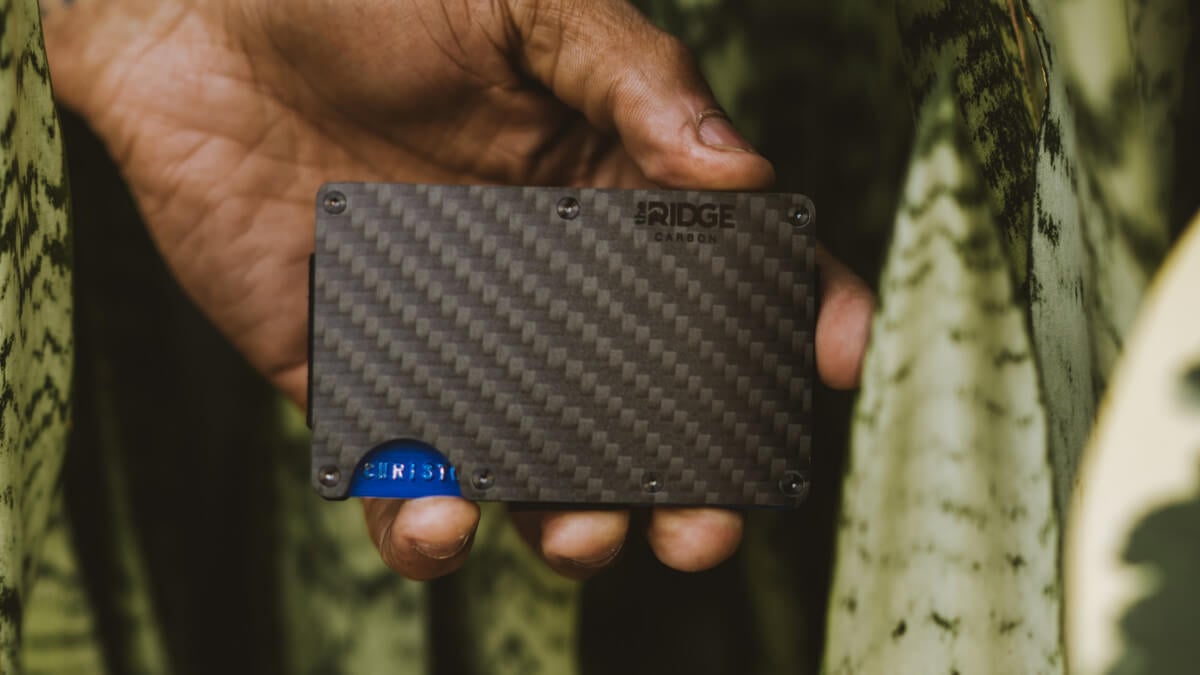In today's digital world, it can feel impossible to keep up with all the different tactics hackers and con artists will use when attempting to steal your money, identity, or - worst of all - both. Staying vigilant to identity theft scams and diligently protecting your credit card information has never been more important.
In this article, we'll teach you how to defend yourself from RFID skimming, a method thieves use to steal sensitive information simply by walking within a few feet of their targeted cardholder. Fortunately, RFID-blocking is effective, affordable, and easy to protect yourself with for better peace of mind.
If you're wondering, "What is RFID-blocking?" and "How does RFID-blocking work?" use the links below for quick answers to your questions at-hand.

What is RFID Technology?
Before we can explain what RFID-blocking means, we first need to establish a better understanding of what radio frequency identification (RFID) is and how it actually works.
RFID is a technology that uses radio waves to read, write, and store data onto a chip attached to an item. The plastic chip is small and flat with an electronic tag and embedded antenna that can transmit information to an RFID reader.
Originally, RFID tags were designed for inventory management and automatic tracking. Today, RFID is used to store and retrieve information on a wider range of everyday items, such as:
- Bank account information on payment cards
- Contactless payment methods on a cell phone
- Personal identification details on a passport or driver's license
- Security credentials on a government-issued badge
- Room access permissions on a hotel key
- Patient records on a hospital wristband
- Contact information on a pet microchip ID
On the one hand, RFID offers benefits to consumers and business owners by making payments faster and easier than ever before. It also facilitates the efficient transfer of complex datasets from one device to another, which can allow, for example, a nurse to quickly learn her new patient’s drug allergies. Organizations still use RFID to track locations, measure performance, and manage the inventory of everything from library books to grocery store items.
While RFID has been around since the 1950s, it wasn't until recently that we began to see its use expand into commercial settings like electronic toll collection and, most notably, as a mainstream form of contactless payment.
Unfortunately, it’s shown consumers that convenience comes at a cost: increased security issues and privacy concerns due to how the technology works.
How RFID Technology Works
- Radio frequency identification technology requires a device (called a "reader") to recognize the location and identification of an object.
- It does this by sending out unique radio frequencies to transmit a signal that activates the electronic tag on the object.
- Once activated, the chip uses energy generated by the electromagnetic waves to transmit information back to the reader's antenna.
- Then, the transmission is electronically translated into data.
This exchange occurs within a matter of seconds, and it does not require the RFID chip to be within the reader‘s direct line of sight. According to SageData, most devices have a reading range of about three feet, but some can reliably scan RFID tags as far as 16 feet away. These devices can be portable, battery-operated, and worse yet, purchased by anyone for cheap.
Therefore, any hacker with a card reader could potentially steal your ID or card details without you even knowing — a crime known as RFID skimming or electronic pickpocketing.

RFID and Credit Cards
Security experts have long warned about the potential risks associated with RFID technology — especially in regards to credit card theft. For example, a report from February 2012 showed statistics provided by the United States Department of Justice indicating a ~30% increase in credit and debit card theft that correlates with the introduction of RFID cards and contactless payments in the early 2000s.
Fast forward about a decade to the end of 2021, in the wake of the coronavirus, when 101.2 million Americans were projectedto use contactless payments. Prior to Covid-19, only a small portion of American adults was using contactless payments, but the pandemic has created a “contactless economy“ in which 87% of all new debit cards and nearly all new credit cards issued by major banks are expected to be RFID-enabled.
This technology allows you to simply tap your payment card or mobile wallet onto the POS (point of sale) terminal rather than inserting an EMV chip or swiping a magstripe. Though RFID is purported to be safer than magstripes without RFID-blocking, every time a person waives their enabled card at the gas pump or drive-thru window, they could jeopardize their financial security.
Even Visa recognizes the risks in their 2009 patent request for an electromagnetic shield device. They first address the pending need for technologies like RFID-blocking by stating, “Due to the increased popularity of smartcards and RFIDs, it is envisioned that they will eventually be used for virtually all transactions involved in banking, health, insurance, social security, tracking, shipping, etc.”
Then, Visa warns, ”Unfortunately... it is entirely possible that a contactless reader may be used for surreptitious interrogation (e.g., data skimming) of the contactless portable electronic devices. In addition, it is conceivable that a contactless reader may be developed or modified to generate a much greater RF signal strength and sensitivity and thereby increase the standard range. Such an enhanced reader may allow surreptitious interrogation of the contactless portable electronic devices from a greater range.”
How Does RFID Blocking Work?
So, what is RFID-blocking going to do in terms of consumer protection? Ultimately, it gives users the ability to block RFID signals by disrupting the electromagnetic waves transmitted by the card reader.
There are many different RFID-blocking products you can buy to shield your vulnerable cards, badges, keyfobs, and more, such as:
- RFID wallets
- RFID purses
- RFID bags
Do You Need RFID Protection?
While RFID chips have become the norm for most new debit and credit cards, nearly all cardholders will need RFID protection. If you’re not sure whether your current bank card has an RFID chip, check to see if it works to pay at any POS with the RFID radio wave symbol.
RFID-blocking shields block any signals to RFID-enabled cards so that no one can access the information without your permission. Remember, it’s not just your money they can steal, but also your personal details, including full names and addresses.
What Are RFID Blocking Wallets and How Do They Work?
RFID-blocking wallets are made from thin, durable metal, such as carbon fiberandaluminum. These special materials prevent unwanted radio frequencies from penetrating the card case and activating the RFID tagon your credit, debit, or ID cards. They’re compact, lightweight, and can hold several cards at once for broad, convenient protection.
Where can I buy RFID-blocking wallets?
Given the surge in popularity of contactless payment methods alongside the advanced tools available to malicious thieves, it’s wise to protect yourself with an RFID blocker. By erring on the side of caution with an RFID-blocking wallet, you can prevent yourself from becoming yet another victim of fraud while still enjoying the benefits that RFID technology has to offer.
Check out the collection of wallets at Ridge.com.









